By Angeline P. Hoffman, White Mountain Apache Reservation
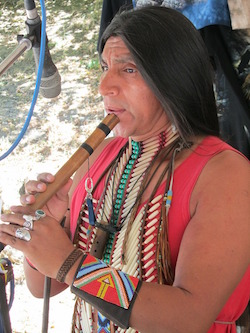 Stories of Indigenous people matter, the stories influence how we think about ourselves, where we come from and formulate the way in which we think about cultural perspectives and people.
Stories of Indigenous people matter, the stories influence how we think about ourselves, where we come from and formulate the way in which we think about cultural perspectives and people.
In looking at storytelling, a sub-theme emerged: ethics and teaching. These specific ideas are utilized by storytellers’ characters to convey these particular values. Teaching is very important in today’s Native American society. Teaching of traditions, cultures and sense of place are practices that are passed on through oral narratives, riddles, jokes, songs and ceremonies (encompassing deep knowledge and beliefs), relationships, time and language. The following text set will consist of a variety of these subthemes from the United States, Canada, and International Indigenous Children’s Literature.
 For a Girl Becoming (Harjo & McDonald,2009).
For a Girl Becoming (Harjo & McDonald,2009).
A story of the joys and lessons of a girl’s journey through birth, youth, and finally entering adulthood.
 A Coyote Columbus Story (King & Monkman, 2007).
A Coyote Columbus Story (King & Monkman, 2007).
“It was Coyote who fixed up the world, you know. She was the one who did it. She made rainbows and flowers and clouds and rivers. And she made prune juice and afternoon naps and toe-nail polish and television commercials.”
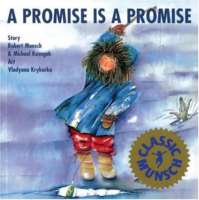 A Promise is a Promise (Munsch & Kusugak, 1992).
A Promise is a Promise (Munsch & Kusugak, 1992).
A beautiful and slightly scary tale to teach children the importance of listening to their parents
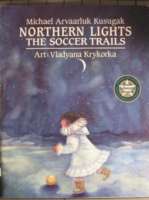 Northern Lights: The Soccer Trails (Kusugak & Krykorka, 1993). The Soccer Trails is an honor to Inuit belief; it would also be a beautiful way to help a child who has suffered a loss.
Northern Lights: The Soccer Trails (Kusugak & Krykorka, 1993). The Soccer Trails is an honor to Inuit belief; it would also be a beautiful way to help a child who has suffered a loss.
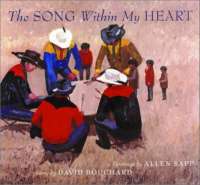 The Song Within My Heart (Sapp & Bouchard, 2002). In this picturebook for older children, Bouchard has crafted lyrical text to accompany Sapp’s paintings. The rhythmic and moving text is based on remembrances from Alan Sapp’s childhood (Cree painter/illustrator).
The Song Within My Heart (Sapp & Bouchard, 2002). In this picturebook for older children, Bouchard has crafted lyrical text to accompany Sapp’s paintings. The rhythmic and moving text is based on remembrances from Alan Sapp’s childhood (Cree painter/illustrator).
 The People Shall Continue (Ortiz & Graves, 1988). This is called a epic story of the Native American People, from the creation to the present day…rhythms of traditional oral narration. The purpose is to instill a sense of responsibility for life.
The People Shall Continue (Ortiz & Graves, 1988). This is called a epic story of the Native American People, from the creation to the present day…rhythms of traditional oral narration. The purpose is to instill a sense of responsibility for life.
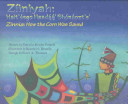 Zinnia: How the Corn Was Saved (Powell, Benally & Thomas, 2003). The story about how the Navajo’s crops failed again, the boy Red Bird is sent to ask Spider Woman for her help.
Zinnia: How the Corn Was Saved (Powell, Benally & Thomas, 2003). The story about how the Navajo’s crops failed again, the boy Red Bird is sent to ask Spider Woman for her help.
 1621: A New Look at Thanksgiving (O’Nell Grace & Bruchac, 2001). Weighs Wampanoag oral traditions and English colonial written records against the popular myth of Thanksgiving.
1621: A New Look at Thanksgiving (O’Nell Grace & Bruchac, 2001). Weighs Wampanoag oral traditions and English colonial written records against the popular myth of Thanksgiving.
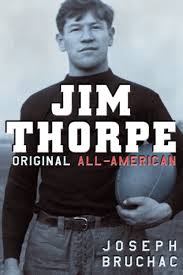 Jim Thorpe: Original All-American (Bruchac, 2006). Told in Jim’s voice and with photos from the time to learn about a truly great Native American. This compelling sports novel brings Jim Thorpe’s early athletic career to life.
Jim Thorpe: Original All-American (Bruchac, 2006). Told in Jim’s voice and with photos from the time to learn about a truly great Native American. This compelling sports novel brings Jim Thorpe’s early athletic career to life.
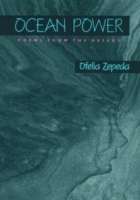 Ocean Power: Poems from the Desert (Zepeda, 2006). In these poems, in O’odham and English, Ofelia Zepeda describes the annual seasons and rhythms of the desert as movements of wind, rain, and flood.
Ocean Power: Poems from the Desert (Zepeda, 2006). In these poems, in O’odham and English, Ofelia Zepeda describes the annual seasons and rhythms of the desert as movements of wind, rain, and flood.
International Indigenous Children’s Literature
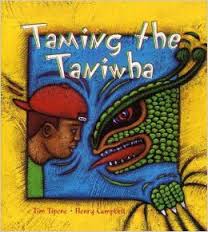 Taming the Taniwha (Tim Tipene and illustrated by Henry Campbell, 2001). Tama is trying to deal with a boy who is a bully and is given advice by people in his life.
Taming the Taniwha (Tim Tipene and illustrated by Henry Campbell, 2001). Tama is trying to deal with a boy who is a bully and is given advice by people in his life.
 In the Beginning (Peter Gossage 2001). A creation story of the Maori people: about father sky, mother earth and their children.
In the Beginning (Peter Gossage 2001). A creation story of the Maori people: about father sky, mother earth and their children.
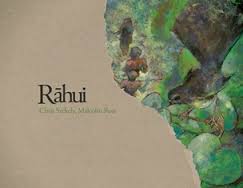 Rahui (Chris Szekely and illustrated by Malcolm Ross, 2011). A story composed of memories in the summer time, including holidays, the rocky shore, family, friends, fun and sadness.
Rahui (Chris Szekely and illustrated by Malcolm Ross, 2011). A story composed of memories in the summer time, including holidays, the rocky shore, family, friends, fun and sadness.
 Pele and the Rivers of Fire (Michael Nordensrom, 2002). Pele, a restless goddess of volcanic fire, journeys across the sea and brings fire to the Hawaiian Islands, even though her sister continually puts her fire out. Pele continually destroys and rebuilds the land in order to bring new life to Hawaii.
Pele and the Rivers of Fire (Michael Nordensrom, 2002). Pele, a restless goddess of volcanic fire, journeys across the sea and brings fire to the Hawaiian Islands, even though her sister continually puts her fire out. Pele continually destroys and rebuilds the land in order to bring new life to Hawaii.
 Enora and the Black Crane (Arone Raymond Meeks, 1993). The main character, Enora, an Aboriginal, follows a shimmering band of colors deep into the rainforest and unexpectedly encounters an act of violence against a crane that changes him forever.
Enora and the Black Crane (Arone Raymond Meeks, 1993). The main character, Enora, an Aboriginal, follows a shimmering band of colors deep into the rainforest and unexpectedly encounters an act of violence against a crane that changes him forever.
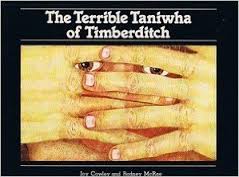 The Terrible Taniwha of Timberditch (Joy Cowley and illustrated by Rodney, 1982). A young girl tries to catch a taniwha (a sacred entity) due to curiosity because everyone has a different opinion on what a taniwha actually is.
The Terrible Taniwha of Timberditch (Joy Cowley and illustrated by Rodney, 1982). A young girl tries to catch a taniwha (a sacred entity) due to curiosity because everyone has a different opinion on what a taniwha actually is.
 Gidja (Percy Trezise and Dick Roughsey, 1984). In Dreamtime, when the world was created, Gidjis the Moon and Yalma the Evening Star had a daughter named Lilga who is killed in an unfortunate accident. The tribal members thought they were immortal and this event causes changes to their lives forever.
Gidja (Percy Trezise and Dick Roughsey, 1984). In Dreamtime, when the world was created, Gidjis the Moon and Yalma the Evening Star had a daughter named Lilga who is killed in an unfortunate accident. The tribal members thought they were immortal and this event causes changes to their lives forever.
I hope an interest of reading has been regenerated for the young, educators, parents and community members, possibly sparking attention to all. Thank you for the privilege of sharing my Indigenous Children’s Literature text set.
Please visit wowlit.org to browse or search our growing database of books, to read one of our two on-line journals, or to learn more about our mission.
- Themes: Angeline Hoffman, Indigenous
- Descriptors: Books & Resources, WOW Currents
